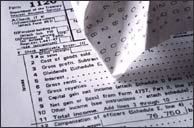Nearly 10 years ago, Wharton finance and economics professor
“Can Philadelphia escape its fiscal crisis with another tax increase?” Inman asked in a 1992 article.
Behind Inman’s question was the realization that the relationship between tax revenues and tax rates is not so simple – for Philadelphia, New York or any municipality faced with a gap between expenditures and revenues. Indeed, the first impulse to “raise taxes” to close that gap may be counterintuitive, Inman has argued. Why? Because if the tax rates go up but the tax base goes down, there may very well be no increased revenue to show for the change.
“The critical concept in this respect is what economists refer to as a revenue hill,” Inman said in a recent interview, describing the “revenue hill” as the simple relationship of tax rate to revenue when presented as a graph. “As the tax rate rises, revenue will rise until the peak of the hill is reached. From there on, revenue will decrease as the tax rate increases. As the rate rises towards 100%, revenue will once again be zero.”
As Inman has demonstrated, understanding the relationship between taxation and revenue is crucial in setting tax rates for cities throughout the country. In New York, three different taxes account for about 80% of the city’s revenue: property tax, sales tax and personal income tax on city residents. Philadelphia follows a similar tax pattern and uses three different taxes to raise the majority of its revenue: a property tax on residential and business property; business taxes on gross receipts and net income; and a wage tax on residents and nonresidents who work within the city.
“The basic relationship underpinning the revenue hill is fairly simple,” said Inman. “As any city’s budget demonstrates, revenue is the tax rate multiplied by the tax base, the tax base being the total economic activity on which taxes are paid. What happens to the tax base if there is an increase in the tax rate? The general effect is that taxpayers, both individuals and businesses, perceive a decrease in the net benefits of working in that city, and either may work less or move elsewhere.
“This effect of a tax rate increase on the tax base is the central relationship behind the revenue hill, as revenues will be the product of the two. If tax rates go up by 10% and the tax base goes down by 10%, there will be no increased revenue to show for the change.”
On the other hand, the tax base generally increases as tax rates are lowered. Economic activity increases and firms, businesses and employees return to the city. Instead of a perceived decrease in the benefits of working and living in a city, individuals are more likely to see an increase. Said Inman: “If tax rates are very high, it is certainly possible that lowering the rates would actually increase the revenues of the government.”
In 1992, when Inman applied his revenue hill theories to Philadelphia, he quickly came to the conclusion that the city was precariously close to the top of its revenue hill. This means that if the city raised taxes in an effort to close the budget gap, there would be little net revenue to show for it – at least not enough to erase the entire deficit. He warned that raising taxes could prove to be a very costly tax strategy, causing people and businesses to actually leave the city and thereby further compromising an already dwindling tax base. His message to Philadelphia’s leaders? “You cannot get out of this mess by simply raising taxes.”
Explained Inman: “As cities get to the top of their revenue hills, there are no longer additional revenues from a tax increase. The only way to increase public services to city residents is to manage those services more efficiently. Governments simply do not have the luxury of moving into a wide range of new services that the private sector now provides more effectively. Governments should only do what governments do well and do so efficiently.”
Inman and several colleagues have applied his revenue hill theories not only to Philadelphia and New York but also to Houston and Minneapolis. “In each city, we estimated the revenue hill. But where (each city) is on the revenue hill depends on local politics and how budgeting plays out.
“Houston, Philadelphia and New York have all chosen to be at the top of their revenue hills. That’s politics,” Inman said. “In these three older
cities, the politics and realities are such that the cities tend to have high poverty levels, crime, strong unions – all pressures that lead to high tax rates and movement to the top of the hill.”
On the other hand, Minneapolis “is three-fourths up the revenue hill. The city doesn’t have much room to maneuver, but it isn’t at the top because there is less political pressure on its tax rates. The city doesn’t face similar issues with poverty and crime that the other cities face.”
The conclusion, said Inman, “is that no two cities are alike, which
shouldn’t be shocking. What lies behind those revenue hills is a regional economy, and each regional economy is unique in its own way. But cities are very similar in the ways politics and budgeting play out.”
As for Philadelphia, the city “escaped its fiscal crisis in the early 1990s for three reasons,” said Inman. First, the city was able to “stabilize the expenditure side” by obtaining favorable union contracts. Second, the city decided to hold the line on tax rates. Third, Philadelphia was able to move out of its financial crisis because “we moved out of the recession. Philadelphia lags national growth, but [that growth] does help us. We were able to stem the job exodus through good fiscal policy, and we actually had some increases in jobs in the mid ‘90s because of the expanding economy.”
Over time, the city was able to capitalize on these three factors and build up a budget surplus of nearly $300 million. But the struggling economy of the past year has taken its toll on the city budget: The surplus was down to $226 million at the end of June, and the wage-tax revenues for the last quarter of the 2001 fiscal year were down slightly less than 1% over the same period last year.
At the same time, the city is faced with two deficit-plagued operations: The Philadelphia school district faces a $1.5 billion deficit over the next five years, and the Philadelphia Gas Works faces a debt of $1.2 billion. In both cases, the city is looking at ways to make the operations more efficient through private management, state take-over or even the sale of PGW.
Inman warns that “the same basic economic relationships that existed in the early 1990s exist today.” In 1992 Inman reasoned that Philadelphia still had some wiggle room on the revenue hill – and could actually raise taxes a bit before compromising the tax base. But he predicted that this move would be very costly.
“Raising city tax rates to their maximum revenue potential costs city residents more than just their tax payments,” he wrote. “House values decline, jobs are lost and business sales and profits fall. This study has estimated that each additional $1 per resident of city revenue will cost that resident approximately $5 annually because of falling home values if the property tax is used, or $8 annually in lost private sector job opportunities if the wage tax is used, or $8 annually in reduced business profits if business taxes are increased. These are the prices city residents must pay for any tax increase.”
Concluded Inman: “We are getting continual confirmation of the validity of those results. Today, we are close to the top of our revenue hill, although we are not over the top. We are not there. But the latest work that we have done suggests that it looks very similar to where we were in 1990 and 1991. The city can raise some money, but it’s not going to be sufficient to maintain services if there is a major downturn in the national economy.”



